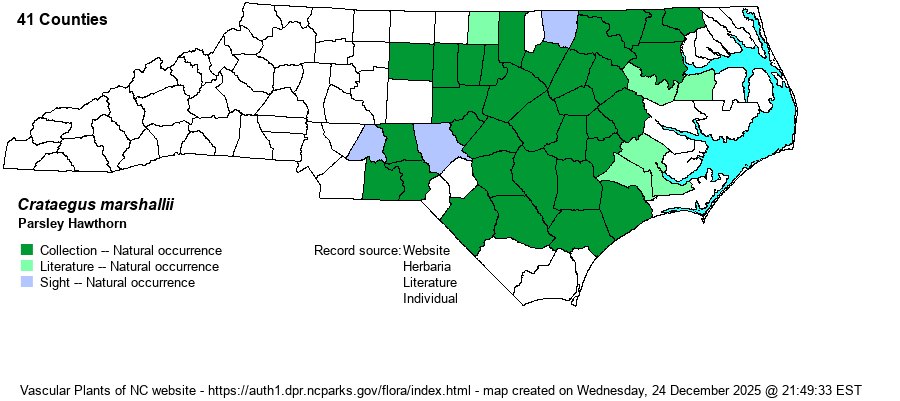| Author | Eggleston | |
| Distribution | Throughout the eastern 40% of the Piedmont and much of the Coastal Plain, but absent from most coastal counties and the Tidewater counties (around Pamlico and Albemarle sounds). Not found in the Mountains or the western Piedmont, known west only to Guilford and Stanly counties. As this is a well-known and distinctive species, its range in the state is much clearer than for most other Crataegus species; the map below should be treated as generally accurate.
This is a Southern species that ranges north only to southern VA and MO, and south to central FL and eastern TX.
| |
| Abundance | Fairly common in the eastern Piedmont and western half of the Coastal Plain, though rare in the Sandhills proper. Scarce in the eastern half of the Coastal Plain. | |
| Habitat | This species prefers bottomland forests, but it can be found in mesic forests, somewhat drier upland forests, and in drier swamps. It is seldom seen in thickets, old pastures, or other sunny places. Where found in drier forests, it is mainly on higher pH soil. | |
| Phenology | Blooms in April and early May, and fruits from September to October. | |
| Identification | This is a small tree, to at times a large shrub, almost always found in shade. It is, by far, the easiest hawthorn to identify, as the leaves are somewhat triangular in overall shape but have several very deep sinuses on each side of a leaf, yielding 5-7 obvious lobes as in some oaks such as Scarlet Oak (Quercus coccinea). Of course, the hawthorn leaves are also strongly serrated along the margins. The bark of the trunk is very scaly and often peeled. Thanks to the very distinctive leaves, there is no need for an observer to bother looking at twig, flower, and fruit characters. In the east-central part of the state, you should encounter this species on every few long walks in bottomlands and other fairly moist sites, though it seldom or never occurs in dense stands. | |
| Taxonomic Comments | Thankfully, this distinctive species has never been lumped into another species, nor has it been divided into varieties.
| |
| Other Common Name(s) | Parsley Haw, Parsley-leaved Hawthorn | |
| State Rank | S4 | |
| Global Rank | G5 | |
| State Status | | |
| US Status | | |
| USACE-agcp | FAC link |
| USACE-emp | FAC link |

